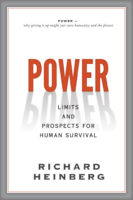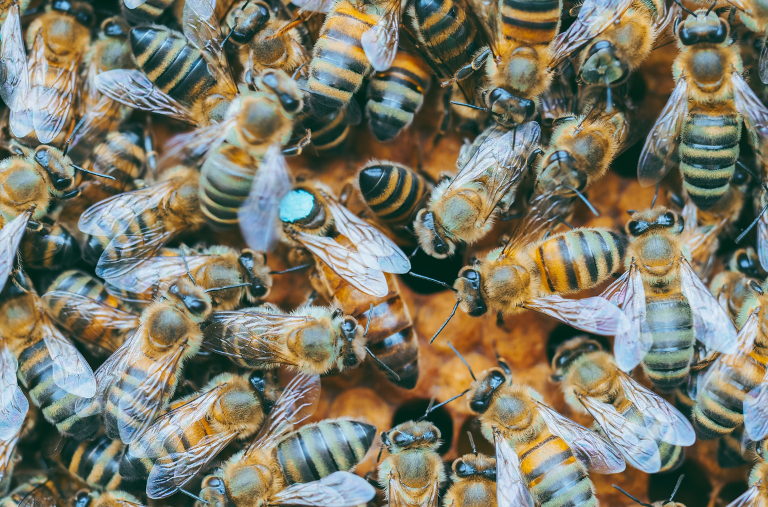 This is an abridged excerpt from Power: Limits and Prospects for Human Survival (2021) by Richard Heinberg; posted with permission from New Society Publishers.
This is an abridged excerpt from Power: Limits and Prospects for Human Survival (2021) by Richard Heinberg; posted with permission from New Society Publishers.
Read more in this series.
The Human Superorganism
As noted in Chapter 1, humans are ultrasocial, similar in this respect to ants or bees. In chapters 2 and 3, we saw how human beings have developed ever more ways of cooperating. We explored the ways in which language and complex social organization have enabled more coordination among individuals. As cultures evolved, writing, money, and Big God religions knitted us even closer together. With fossil fuels and electrification, and thus greater mobility and instant communications, we have indeed become a human “hive.” Any one of us can walk into a store and, assuming we have the appropriate symbolic tokens (cash or a credit card), we can immediately do business with complete strangers. We have faith that strangers will protect us in the case of physical threat, treat our injuries, and make sure we have water and electricity. When we enter a restaurant and sit at a table, we and the server don’t have to spend many tense minutes determining whether one of us has hostile intentions. The general shape of the interaction is already agreed upon, as the result of centuries of server-patron encounters at millions of restaurants. We look at the menu, order food, and within minutes we’re eating. A tip is expected, and we leave one.
That’s cooperation. And it makes us, as a species, collectively powerful. Acting together, we have the ability to commandeer and direct flows of energy originating in millions of years of stored ancient sunlight. We have the power to extract thousands of different resources scattered across the planet, transport them, transform them with thermal and chemical processes, and assemble them into a numbing array of consumer products. Because we act together in so many ways and contexts, we as individuals can travel around the globe in hours. We can see events happening far away as they occur, communicate instantly with co-workers, or press a key and have a product delivered to our doorstep in hours. And we can devastate entire ecosystems without even realizing what we are doing. We take these levels and kinds of cooperative power for granted. Indeed, we often think that our biggest problem, as humans, is that we aren’t cooperative enough. After all, we squabble endlessly over politics—so much so that it’s often hard for democracies to get anything done. We bicker and fight over inequality and access to resources. We’re so fiercely competitive that we even create objectively meaningless opportunities for competition via sports teams and their ritualized clashes. But even when we compete, squabble, bicker, and clash, it is within the context of extraordinary degrees of cooperation. Within our teams, we work in synchrony, and cheer on our teammates. Indeed, war makes us even more cooperative than we are normally, willing to sacrifice even our lives for the sake of the “team.”
We evolved from primates that lived in small groups and that cooperated little more than hyenas, wolves, crows, or dozens of other social animals do. But gradually, bit by bit, over millions of years, we developed teams that were bigger and more coordinated, until they comprised hundreds, then thousands, then millions, and now billions of increasingly specialized humans. The end result is a global team that acts, at least to some degree, as a collective unity, together making up the human Superorganism—which wields vastly more power than any other single organism in Earth history. The idea that humanity currently comprises a Superorganism is propounded by sociobiologists like Edward O. Wilson and cultural evolution theorists such as Peter Turchin. Kevin Kelly, founder of Wired magazine, popularized the notion among techno-geeks with his 1994 book Out of Control. While there are skeptics, particularly among some traditional evolutionary theorists, the idea that ultrasociality can lead to the emergence of superorganisms explains how and why groups of individual organisms can exhibit coordinated collective action, collective homeostasis (in which the group as a whole maintains self-regulation of various parameters, such as defense of group boundaries), and emergent behaviors (that is, behaviors of the group that emerge from the relationships of individuals to one another, and that cannot be predicted on the basis of a thorough knowledge of the individuals themselves).
The superorganism is more than the sum of individual decisions. Indeed, once a superorganism emerges, individual choices tend to be constrained by the demands of the collective entity. The global human Superorganism (with a capital “S,” signifying the entity that now encompasses our entire species) is still quite young. We became ultrasocial during the last 10,000 years, especially as we began living among strangers in cities. For the next few millennia, nations acted as superorganisms, cooperating internally to accomplish their overarching goals. But the birth of the universal human Superorganism occurred much more recently, in the late 20th century, with the advent of the global economy and instant global communications. That certainly wasn’t long ago in terms of biological evolution, or even cultural evolution. The sheer power of the Superorganism is staggering. Each year, it cuts and uses up to seven billion trees; it excavates 24 million metric tons of copper and nine billion short tons of coal; and it produces (and brews and drinks) one billion tons of coffee. In order to mine resources and construct buildings and highways, it moves up to 80 billion tons of soil and rock. The Superorganism is taking control of Earth, and the Anthropocene is its era of dominance. Some still argue that the power of the Superorganism is just the sum of the powers of eight billion humans. But if not for the coordination and cooperation that enable the existence of the Superorganism, there wouldn’t be eight billion humans, and each of the non-networked humans who did exist would be wielding far less power per capita than is the case today. On one level, the Superorganism may be merely a concept or metaphor, but it is a useful one because it points to a reality that is crucially important for us to understand and grapple with if our species is to survive the 21st century.
This is an abridged excerpt from Power: Limits and Prospects for Human Survival (2021) by Richard Heinberg; posted with permission from New Society Publishers.
Read more in this series.
Teaser photo credit: A beekeeper inspects a hive frame with honeycomb, showing capped honey and brood cells. The modular design allows for easier management and non-destructive harvesting of honey and beeswax. Photo Ante Hamersmit from Unsplash.






